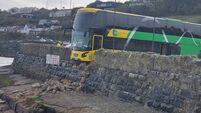Radon gas project earns young scientists trip to US

Shauna Murphy and Caoimhe Cronin were so intrigued about the fact that Mallow has some of the world’s highest levels of radon gas — the second-biggest cause of lung cancer —that they decided to find out more and entered their work at this month’s BT Young Scientist & Technology Exhibition.
It was so impressive that they were selected for the Intel Student of Excellence Award, given each year for a project in the event’s physics, chemistry and maths section.
The pair not only tested for radon in more than 40 homes, they also investigated radon’s presence in soil outside of homes and the water supply.
Among their findings was that homes with high radon levels in the ground outside also had high levels inside, showing how the deadly gas that seeps up from bedrock makes its way into people’s houses.
“We want to raise awareness locally because people in Mallow don’t all know about the problem,” said Caoimhe, who is from Mourneabbey.
The two students at St Mary’s Secondary School will be joined by science teacher Martin Timmons on the trip in May to the Intel International Science and Engineering Fair in Pittsburgh. But not before they have done more investigations, including plans to put their simple testing kits into more homes locally.
Their study found high radon levels in almost two-thirds of homes tested and in six of the eight rooms at their school, which had a radon barrier installed as part of development work over a decade ago.
“There were also radon pumps put in, and the levels went down. But the levels are very high again in some rooms, and we found this could be linked to ventilation,” said Shauna.
The students believe their findings show that remediation works, but needs to be supported by good ventilation. Their findings could prompt further research on the effectiveness of mitigation measures to tackle radon.
The students stressed it is important people in hot-spots like Mallow have their homes or workplaces detected, suggesting use of short-term testing initially and longer testing with kits supplied by the Radiological Protection Institute of Ireland if high levels are detected. In 2007, a room at the Corkman newspaper’s offices was found to have radon levels 60 times the acceptable limit.
The girls’ testing in plants found higher levels in lower leaf surfaces. This, they said, could have implications for the food chain as it could impact grazing animals, as well as grown foods.












